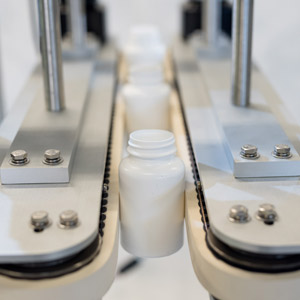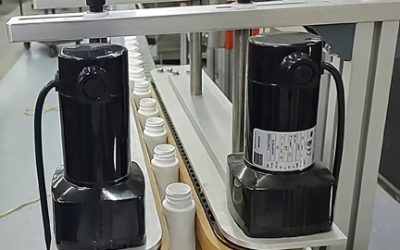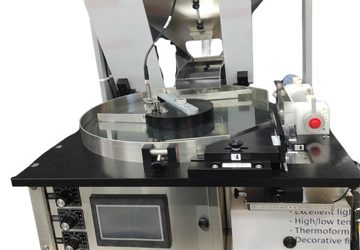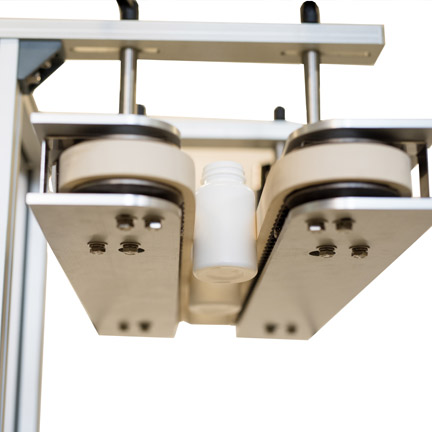As Featured in Tablets & Capsules, June 2025
How the Latest Entry-Level Machines Boost Production
By John Deitz
When a pharmaceutical or nutritional product captures the news cycle as the solution to the health crisis of the day, the manufacturers in the right place at the right time rejoice at the spike in sales. But the pressure to boost production to meet intense consumer demand may quickly overwhelm smaller companies that rely on manual methods for bottle filling and packaging.
Repetitive, time-consuming, labor-intensive tasks like inserting desiccants, applying tamper-evident shrinkbands and heat sealing them may seem tolerable for an owner-operator or small team filling small orders, however as demand surges, these tedious processes become bottlenecks impacting efficiency and capping profit potential. That’s when owners and managers often take a fresh look at the state of packaging automation and consider whether they can afford to begin automating their manual filling and packaging processes.
Calculating the Cost of Manual Bottle Filling
To determine whether the numbers support investing in automated machinery or continuing to rely on manual labor, the first step is to review the current costs and compare how the cost structure changes in an automated system. It is easy to calculate the quantifiable costs of manual bottle filling by breaking down the process into its typical individual steps:
- Tablet counting
- Unscrambling and readying empty bottles
- Desiccant insertion
- Tablet filling
- Cotton insertion
- Bottle capping
- Labeling
- Tamper-evident band application
- Heat sealing tamper-evident band
- Bottle bottom coding
- Cartoning
It is possible to perform these tasks by hand, and given a large enough number of employees in a large enough facility, it is possible to fill a large number of bottles in a given amount of time. But at what cost? Using just two employees, each paid $18/hour on an eight-hour shift, five days/week, the labor cost is $6,240.00/ month or $74,880.00/year in wages. This is without factoring the cost of health care, 401(k), and other employee benefits. Based on the price consumers expect and are willing to pay for vitamins, herbal supplements and OTC drugs, paying for even one more worker than is essential may compromise profitability.
What about the costs involved in a manual operation that cannot be easily quantified? While a worker may be physically capable of counting out 200 tablets and placing them in bottles, over time, human error naturally leads to undercounts that infuriate customers and overcounts that quickly add up and become a drain on costs. Did any chipped pills get bottled? Are you sure there’s a desiccant placed in every bottle? What about the cotton? Cutting tamper-evident bands consistently to just the right size so they sit on the bottle neck properly is no easy task, and if done haphazardly, the shrinkbands cannot seal over the cap correctly and the entire banding and heat sealing process must be redone. If heat sealing is done by hand using a heat gun then the human penchant for error consumes even more time and eff ort. The physical pill handling also invites contamination. Then try to apply printed labels onto hundreds of round bottles accurately by hand every time. Misapplying labels renders the entire bottle as waste and probably all of the steps that preceded the labeling mishap, or, if tolerated, this presents a less than professional image that may make customers question the safety and efficacy of the product.
In addition to the failures due to human error, manual filling requires thorough training and managerial supervision to ensure staffers work at peak efficiency to meet throughput targets while also abiding by proper quality control protocols. This assumes the workers show up each day as anticipated. A single sick day or vacation day may delay production or cause other workers to work faster to compensate, leading to errors and/or cutting corners. Add $132,000.00/year in wages plus benefits for a packaging manager or supervisor, depending on the size and scope of the operation.
Safety in Numbers
In regulated processes, proper record-keeping is an essential step that protects against liability and aids in effectively responding to an investigation or recall. Manual filling and packaging requires manual record-keeping. This is often performed at the beginning and end of a shift using pen, paper and a three-ring binder. Even if logged by hand into a computer, this method still takes time, invites opportunities for human error, and offers a questionable level of data integrity. Further, analyzing the written data from one shift to another and drawing actionable conclusions for process improvement is a challenging and time-intensive process.
The less tangible costs of manual record-keeping — catching errors and performing rework; allowing mispackaged products to slip through the process; recruiting, training, motivating and retaining staff; and the opportunity cost of missing out on additional sales — raise the cost of manual operations far beyond wages alone. In fact, though the workers in our example are paid for an eight-hour shift, the time involved in preparing packaging materials, unplanned stoppages, taking breaks, and other factors typically prevent a full eight hours of production, so the costs are actually higher than in our calculation.
Labor Efficiency in Manual Packaging
How workers are deployed when filling and packaging by hand plays a key role in the efficiency of the operation. Consider that if a line operates at 10 bottles/minute, then each step must be performed in six seconds or less. One worker can unscramble or remove an empty bottle from a carton, place a desiccant inside, and send it downstream for filling, but counting the pills cannot be done by hand with a high level of accuracy for hours at a time. Adding cotton atop the pills is a two-step process involving tearing a piece from a continuous roll and stuffing it into the bottle in such a way that it doesn’t rise over the rim, which could prevent the capper from applying the bottle cap correctly. Cottoning by hand takes some skill and is difficult to repeat consistently 10 times/minute let alone 4,800 times over eight hours. Further, the physical distance between steps and the timing involved dictate that it would be quite an impressive feat for one worker to handle even two of these steps.
To illustrate, consider the calculation focusing only on the tamper-evident band application and heat sealing steps: At 10 bottles/minute in an eight-hour shift, workers need to apply 4,800 shrinkbands onto bottles then heat seal the 4,800 shrinkbands. In a five-day workweek, this translates to 23,990 tasks. Add 11,995 tasks for each additional step, such as inserting cotton, and it quickly becomes clear that hundreds of thousands of repetitive tasks are involved in filling bottles and packaging them for safe, timely delivery.
To this point, the quantifiable out-of-pocket cost of applying and heat sealing tamper-evident bands by hand is $6,240.00/ month. The true cost accounting for human error, missed work days, quality failures, managerial headaches, and other factors are incalculable.
Calculating Returns on Automating
Using the preceding tamper-evident banding and heat sealing example for an apples to apples comparison, replacing the manual method with automated neck banding and heat sealing machinery cuts the time/task from six seconds to one second. All else being equal, this multiplies the throughput rate by 600% and increases production from 10 bottles/minute to 60 bottles/minute while freeing the two employees to take on other tasks that may be less suited to automation for a monthly savings of $8,060.00, incorporating labor efficiency. Apply this concept to automating the entire filling line to a uniform throughput rate and the savings approach thousands of dollars daily depending on the volume.
All else isn’t equal, however. The latest tamper-evident neck banding machinery does more than speed the process. It also cuts the shrinkbands precisely to the required length every time, ensures any perforations are applied in the correct position and that the band heat seals evenly around the entire neck and cap. The latest heat shrink tunnels direct the heat at preset points on the shrinkband to establish a smooth seal in only a few seconds using the least amount of heat energy possible. Product loss, material waste, and costly rework due to human error or the shortcomings of human capabilities are eliminated as product quality, consistency, uniformity and safety are vastly upgraded.
To assess the returns on automating these two steps, if the initial investment cost of a tamper-evident band application machine and companion heat tunnel with temperature-resistant conveyors totals $39,809.00 and the monthly savings that can be tied directly to these machines totals $8,060.00, then the investment pays for itself in five months. Then add approximately $8,000.00 in tax savings as immediate deductions via Section 179 and the calculation becomes even more compelling.
However, in many cases, automating the process not only frees workers to handle more productive tasks but it also frees management to pursue and accept larger orders from more customers on tighter deadlines with new confidence. When packaging becomes viewed as a dependable, predictable asset capable of working unattended 24/7 — rather than as a limiting factor in production — growth and profitability can soar.
Starting with Entry-Level Automation
As consumer demand fluctuates and competitive pressures intensify, manufacturers relying on manual labor remain vulnerable to production bottlenecks, staffing challenges, and rising labor costs. In contrast, an automated packaging line offers the speed and flexibility to scale production without increasing overhead. For small and mid-sized manufacturers, the hesitation to invest in automation is often rooted in concerns over initial cost. However, as the calculations demonstrate, the return on investment even when automating only one or two steps in the process is often measured in months, not years.
When seemingly minor inefficiencies and occasional human errors compound over thousands of units, and automated filling and packaging equipment are becoming the standard for cost control, then the cost of inaction becomes the true financial burden. Given access to advanced automated technology that anyone can use at reasonable, entry-level pricing, manufacturers taking a fresh look at automating the process may realize they can no longer afford not to automate.
John Deitz is president at Deitz Company in Wall, NJ. The company designs and manufactures the Pharmafill(TM) line of tamper-evident neck banders, heat tunnels, turntables, conveyors, tablet counters, desiccant and cotton inserters, and other automated packaging machinery and accessories. Deitz also provides complete filling line design and installation services.






